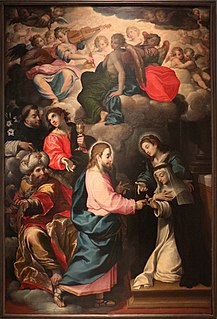Related Research Articles
Francesco Ange (1675–1757) was an Italian painter of the late-Baroque period. Born in Annesi and trained in Bologna. He joined the Philippine order established by Saint Phillip Neri.
Giacomo Argente was an Italian painter of the Baroque period, specializing in portrait miniature. He was born in Ferrara in the 17th century, and was mainly active in Turin.
Francesco Aureri was an Italian sculptor of the Renaissance period, active in Cremona.

Domenico Auria was an Italian architect and sculptor of the Renaissance period, active in Naples. He was a pupil of Marliano da Nola. He is also known as Giovanni Domenico or Giovan Domenico Auria, or Domenico d'Auria.
Francesco Baratta the elder was an Italian sculptor of the Baroque period.
Giovanni Bartoli was an Italian sculptor and jewelmaker of the 14th century in Rome. In 1369, he completed for Pope Urban V, silver busts of Saints Peter and Paul for San Giovanni Laterano.
Giovanni Battista Bellandi was an Italian sculptor, active in Milan for its elaborately decorated Cathedral.
Giovanni Bellati was an Italian painter active in the Neoclassic period. He was born in Valsassina. He studied in Milan at the Brera Academy, but then traveled to Rome.

Marco Bello was an Italian painter active in the Renaissance period. He was one of the pupils in the studio of Giovanni Bellini.
Bartolomeo di Cassino was an Italian painter active in the Mannerist period. He was born in Milan. He was a pupil of Vincenzo Civerchio.
Damiano del Barbiere was an Italian stuccoist and sculptor of the Renaissance period, recruited by Primaticcio to help in the labors at the palace of Fontainebleau.

Lodovico Bertucci was an Italian painter of the Baroque period, specializing in paintings of bambocciate and capricci. He was born in Modena.
Carlo Girolamo Bersotti was an Italian painter, active during the Baroque period in Milan. He was a pupil of Carlo Sacchi (1617-1703), and painted mainly landscapes, still lifes, and animals. Also called Borsotti.
Carlo Bozzoni was an Italian painter of the Baroque period. He trained with his father, the painter and engraver, Luciano Bozzoni.

Simone Brentana was an Italian painter of the Baroque period, active in Verona. He was born in Venice to Domenico Brentana, but became orphaned by age nine. After a prolonged desultory education in various fields including music, he trained as a painter in Venice with Pietro Negri, frequenting the Accademia di Belle Arti, moving in 1685 to Verona, where most of his paintings are located.
Francesco Brambilla was an Italian sculptor of the Renaissance period, active in Milan, in the decoration of its massive gothic Cathedral.

Francesco Corneliani (1740-1815) was an Italian painter, mainly active in a Neoclassic style in his native Milan.

Cristoforo Agosta or Agosti or Augusta was an Italian painter of the Mannerist style.
Cristoforo Ciocca (1462–1542) was an Italian painter of the late-Renaissance, active in Milan. Little biographical information is known, except that he was the pupil of Gian Paolo Lomazzo. He painted a San Cristoforo altarpiece for the church of San Vittore al Corpo, Milan. He mainly painted sacred subjects and portraits.
Giuseppe Crastoni or Gioseffo Crastone or Crastona was an Italian painter, mainly active as a landscape painter.
References
- Dictionary of Art Historians
- Ticozzi, Stefano (1830). Dizionario degli architetti, scultori, pittori, intagliatori in rame ed in pietra, coniatori di medaglie, musaicisti, niellatori, intarsiatori d'ogni etá e d'ogni nazione' (Volume 1: A-D). Milan: Gaetano Schiepatti.
- Ticozzi, Stefano (1818). Dizionario dei pittori dai Rinovamento delle Belle Arti Fino al 1800' (Volume 1: A-L). Milan: Vincenzo Ferrario.
- Ticozzi, Stefano (1813). Storia dei letterati e degli artisti del Dipartimento della Piave. Belluno: Francesco Antonio Tissi.